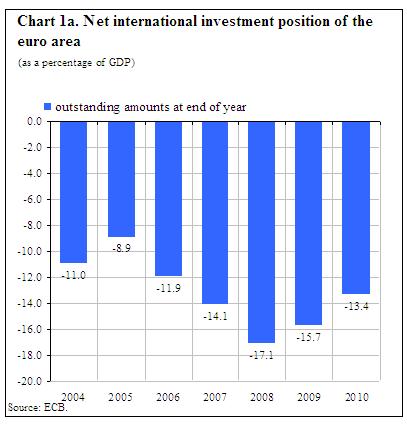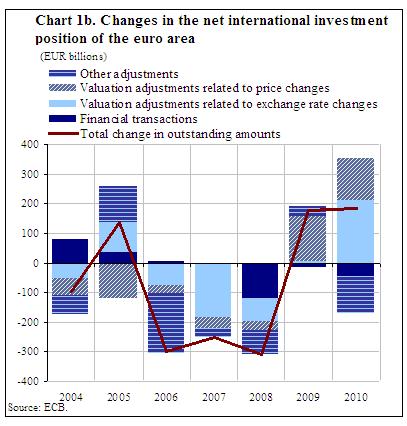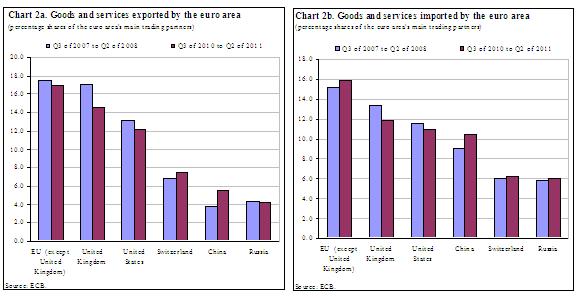Euro area international investment position and its geographical breakdown at the end of 2010 and geographical breakdown of the current account up to the second quarter of 2011
The international investment position of the euro area vis-à-vis the rest of the world recorded net liabilities of €1.2 trillion (13% of euro area GDP) at the end of 2010, €179 billion less than at the end of 2009. This change was mainly the result of positive revaluation effects due to exchange rate changes (€211 billion) and price changes (€141 billion).
At the end of 2010, 21% of the euro area’s stock of direct investment abroad was in the United Kingdom and 19% was in the United States, while these two countries’ shares in the stock of foreign direct investment in the euro area were somewhat larger (with 31% originating from the United Kingdom and 25% originating from the United States). The portfolio investment assets of euro area residents mainly reflected holdings of securities issued in the United States (32%) and the United Kingdom (21%).
Four-quarter cumulated data for goods and services up to the second quarter of 2011 showed that non-euro area EU Member States (excluding the United Kingdom) represented the euro area’s primary trading partner, accounting for 17% of goods and services exported by the euro area and 16% of goods and services imported by the euro area, followed by the United Kingdom and the United States.
The international investment position as at end-2010
At the end of 2010 the international investment position (i.i.p.) of the euro area vis-à-vis the rest of the world recorded net liabilities of €1.2 trillion (13% of euro area GDP), €179 billion less than the revised end-2009 position, which totalled 16% of euro area GDP (see Chart 1a).

The decrease in the net liability position from end-2009 to end-2010 was mainly the result of revaluation effects stemming from exchange rate changes (€211 billion) and price changes (€141 billion), which were only partly offset by other adjustments (€129 billion) and net transactions (€44 billion; see Chart 1b). Compared with 2009, exchange rate changes and other adjustments had a much larger impact on the euro area’s net liability position, whereas price changes and net transactions had a similar effect.
Net financial transactions were driven mainly by non-residents’ net purchases of euro area debt securities (€165 billion) and equity securities (€129 billion), which exceeded euro area residents’ net purchases of equity securities and debt securities issued outside the euro area (€146 billion).
Revaluations reflecting price changes resulted in net price increases of €141 billion in 2010. These were mainly recorded in reserve assets (€102 billion), reflecting the 39% increase seen in the price of gold. In addition, direct investment and portfolio investment recorded price increases of €48 billion and €36 billion respectively, reflecting the fact that the price increases seen in non-euro area stock market indices were larger than those seen in the euro area.
Changes in outstanding amounts as a result of exchange rate changes (€211 billion) reflected the euro’s depreciation vis-à-vis other currencies in 2010 (e.g. its 7% depreciation against the US dollar and its 18% depreciation against the Japanese yen). In 2010 changes in the i.i.p. as a result of exchange rate developments were due mainly to the revaluation of foreign currency in direct investment (€103 billion) and portfolio investment (€78 billion).
Other adjustments in portfolio investment mainly reflected a number of investment funds changing their place of residence to the euro area.

The geographical breakdown of the international investment position as at end‑2010
At the end of 2010 the stock of euro area direct investment abroad totalled €4.8 trillion, with 21% invested in the United Kingdom, 19% invested in the United States, 12% invested in offshore financial centres, 10% invested in Switzerland and 7% invested in other non-euro area EU Member States. The stock of foreign direct investment in the euro area totalled €3.7 trillion, with 31% from the United Kingdom, 25% from the United States, 15% from offshore financial centres and 8% from Switzerland. Only 1% of foreign direct investment in the euro area came from other non-euro area EU Member States. Compared with 2009, the shares of the euro area’s main partners remained broadly unchanged. The United Kingdom continued to be the largest net direct investor in the euro area (€171 billion) and the other non-euro area EU Member States continued to be the largest net recipient of direct investment by the euro area (€292 billion).
As regards portfolio investment, euro area holdings of foreign securities totalled €4.9 trillion at the end of 2010, largely reflecting holdings of securities issued in the United States (which accounted for 32% of the total), the United Kingdom (21%) and offshore financial centres (9%). Non-residents’ holdings of euro area securities totalled €7.4 trillion at the end of 2010.
Turning to other investment, euro area residents’ outstanding holdings abroad (e.g. loans to non-residents by euro area MFIs or deposits held by euro area residents with non-euro area MFIs) totalled €5.0 trillion at the end of 2010, with 37% in the United Kingdom, 14% in the United States and 12% in offshore financial centres. Other investment in the euro area (e.g. deposits held by non-residents with euro area MFIs or loans to euro area residents by non-euro area MFIs) totalled €5.3 trillion at the end of 2010, with the United Kingdom accounting for 39%, the United States accounting for 15% and offshore financial centres accounting for 11%.
The geographical breakdown of the four-quarter cumulated current account up to the second quarter of 2011
The four-quarter cumulated current account of the euro area up to the second quarter of 2011 showed a deficit of €54.7 billion (0.6% of euro area GDP), compared with a deficit of €18.2 billion a year earlier (see Table 3). This increase resulted mainly from the goods account shifting from a surplus of €33.6 billion to a deficit of €4.7 billion and the current transfers deficit growing from €97.1 billion to €103.7 billion, developments which were partly offset by an increase (from €42.1 billion to €51.1 billion) in the surplus for services. The surplus for income decreased slightly, falling from €3.1 billion to €2.6 billion.
While the shift in the goods account was predominantly due to an increase (from €79.9 billion to €140.3 billion) in the deficit vis-à-vis “other countries” (particularly China, with the deficit vis-à-vis this country growing from €86.6 billion to €108.7 billion), the increase in the current transfers deficit mostly reflected an increase (from €49.3 billion to €54.7 billion) in the deficit vis-à-vis EU institutions. The increase in the surplus for services was mainly due to an increase (from €19.7 billion to €25.9 billion) in the surplus vis-à-vis “other countries”.
The four-quarter cumulated data up to the second quarter of 2011 revealed that non-euro area EU Member States (excluding the United Kingdom) represented the euro area’s primary trading partner, accounting for 17% of goods and services exported by the euro area and 16% of goods and services imported by the euro area, followed by the United Kingdom and the United States (see Charts 2a and 2b).

Data revisions
This press release incorporates a revised set of balance of payments (b.o.p.) and international investment position statistics for the period 2008-10 (see Table 4).
The revisions to the current account did not significantly alter the data published previously. In the financial account of the balance of payments, revisions primarily concerned net portfolio investment in 2008, financial derivatives and other investment liabilities in 2009, and portfolio investment liabilities and other investment assets in 2010. The main changes to portfolio investment were due primarily to the refinement of the systems used to collect and compile portfolio investment data on a security-by-security basis, which have been in place in all euro area countries since 2009. The revisions to other investment related mainly to other sectors.
In the i.i.p., the revisions for 2008 and 2009 resulted in a decrease in the euro area’s net liability position. This ultimately resulted in the euro area’s net liability position as at end-2010 being revised upwards (by €40 billion) to stand at €1.2 trillion, higher than the figure published previously for the fourth quarter of 2010.
Additional information on the euro area’s balance of payments and international investment position
This press release breaks year-on-year changes in the international investment position down into valuation adjustments resulting from price changes, exchange rate changes and other adjustments (e.g. the reclassification of items, write-downs, changes in survey coverage and changes to companies’ place of residence). This breakdown is obtained by modelling non-transaction-related changes in the i.i.p. using information derived from the geographical breakdown and currency composition of assets and liabilities, as well as price indices for different financial assets.
Additionally, this press release breaks direct investment in equity down into investment in listed companies, investment in unlisted companies and investment in real estate. While direct investment in listed companies is valued on the basis of the market prices observed on stock exchanges, investment in unlisted companies is valued on the basis of the books of the companies being financed. For analytical purposes, listed companies’ valuation at book value is provided as a memorandum item, although it is not considered in the calculation of total direct investment.
A geographical breakdown of the euro area’s international investment position at end-2010 and the quarterly balance of payments is not available for portfolio investment liabilities, financial derivatives or reserve assetsIn addition, no separate data are provided for investment income payable to Brazil, China, India or Russia; furthermore, for offshore financial centres and international organisations, data are available only for the financial account.
In this press release, data for the current and financial accounts are not working day or seasonally adjusted.
A complete set of updated euro area balance of payments and international investment position statistics (including debt securities broken down by currency of denomination) is available in the “Statistics” section of the ECB’s website under the headings “Data services”/“Latest monetary, financial markets and balance of payments statistics”. These data, as well as historical time series for the euro area’s balance of payments and international investment position, can be downloaded from the ECB’s Statistical Data Warehouse (SDW). They will also be published in the November 2011 issues of the ECB’s Monthly Bulletin and Statistics Pocket Book. Detailed methodological notes are available on the ECB’s website. The next press release on the euro area’s monthly b.o.p. will be published on 21 November 2011.
Annexes
Table 1 – International investment position of the euro area, including a breakdown of changes from end-2009 to end-2010
Table 2a – Geographical breakdown of the euro area’s international investment position at end-2010
Table 2b – Geographical breakdown of the euro area’s international investment position at end-2009
Table 3 – Balance of payments of the euro area with a geographical breakdown
Table 4 – Revisions to the euro area’s balance of payments and international investment position
Bank Ċentrali Ewropew
Direttorat Ġenerali Komunikazzjoni
- Sonnemannstrasse 20
- 60314 Frankfurt am Main, il-Ġermanja
- +49 69 1344 7455
- media@ecb.europa.eu
Ir-riproduzzjoni hija permessa sakemm jissemma s-sors.
Kuntatti għall-midja

